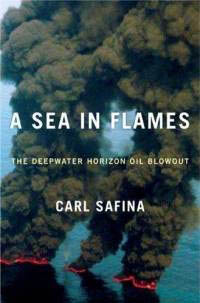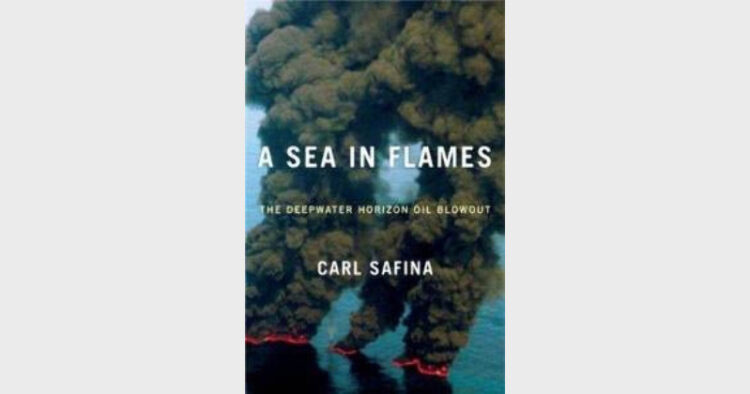 BP oil spill: Callous corporate; profiteering, pedalling old technology?
BP oil spill: Callous corporate; profiteering, pedalling old technology?
By Dr R. Balashankar?
A Sea in Flames: The Deepwater Horizon Oil Blowouts, Carl Safina, Crown Publishers, Random House Inc., Pp 352 (HB), $25.00.?
The multinational giant BP (British Petroleum) has handed out a bunch of lies, lame excuses and passed the buck around for the as yet most dangerous oil spill, which began on April 20, 2010. At the bottom of it was cutting corners for profit and by-passing thorough measures for safety, to save on expenditure. The price for it has been paid by uncountable number of marine species. The human beings were at least partially compensated.
Unraveling the story blow by blow, Carl Safina in his book A Sea in Flames: The Deepwater Horizon Oil Blowout says BP chose options that were ‘cost-effective’ which in fact meant saving expenditure to push up revenue. For instance, “BP had to implement an important well-design decision: how to secure the final 1,200 or so feet and, for eventual extraction of the petroleum, what kind of “production casing” workers would run inside the protective casing already in the well.” There were two options, either to hang a steel tube from the bottom of the previous casing, already in the well, or to run one long string casing from the seafloor all the way down to the bottom of the well. This option saved time (three days) and money. The other option would have cost $7 to $10 million more. BP settled for the long string option which was described by experts as “without a doubt a riskier way to go.”
What is worse is that right from the beginning, BP was lying about the extent of the leak and the damage it posed to humans and the marine life. Carl Safina, a conservationist, counted among the top 100 in the world, travelled across the Gulf of Mexico assessing the damage, lifting the carpet laid by the BP to expose the dirt below. The essential point of Safina is this: If BP had been more careful and not “cost effective,” if it had been more honest right from the beginning about the leak, and more willing to take responsibility for it, the damage could have been minimized. It is a classic case of balance sheets being more important than lives both human and other beings.
The cement used for sealing the casings had failed the testing parameters. “Halliburton altered the testing parameters, but the cement failed several tests. Finally just days before the blowout, one last test indicated that the cement would remain stable… In other words, when Halliburton pumped cement into the BP well, both companies apparently possessed lab results indicating that what they were doing was unsafe.”
The quantum of oil spilling into the ocean was revised day by day, never really giving a complete picture. And the time that would be taken to fix the trouble was also getting extended at every previous deadline, with the BP “always trying its best.” Overnight fishermen lost their jobs and livelihood, setting off a chain of out-of-job phenomena.
Safina points out how Obama who came to power promising no more deep sea explorations allowed more wells under pressure from lobbyists. The American administration has been rigged with lobbyists of big businesses. For instance, when scientists world over concluded that climate change was happening and measures needed to be taken, “the Bush White House deleted every reference to climate change and carbon emissions.” “Many of these deletions were made by a guy names Philip Cooney. He was chief of staff for the Bush White House’s Council on Environmental Quality. His previous job had been as a lawyer and lobbyist for the American Petroleum Institute, and his next job was with Exxon Mobil.”
An estimated 60,000 barrels of oil from the leak was pouring into the ocean daily for months. Thomas Friedman writing in The New York Times said “This oil spill is like the subprime mortgage mess, a wake-up call and an opportunity to galvanize radical change that overcomes the powerful lobbies and vested interests that want to keep us addicted to oil.”
Carl Safina, travelling through the affected coast six months after the spill found moderate to heavy oil washing ashore “almost one hundred miles of Louisiana’s shoreline. And when Louisiana State University scuba divers go for a look into the waters off of St. Bernard and Plaquemines Parishes, they see oil everywhere.”
Passionate, perceptive and pained, the narrative of Carl Safina on the largest ever oil tragedy makes compelling read. The damage to life around the Deepwater Horizon is saddening. It gets compounded by the deceit played by the dollar wagers, for whom all values are read in the stock listings and profit margins. Carl Safina, a conservator and a MacArthur Fellowship recipient and founder of the Blue Ocean Institute, has authored several books.
(The Crown Publishing Group, 1745 Broadway, New York, NY 10019)













Comments